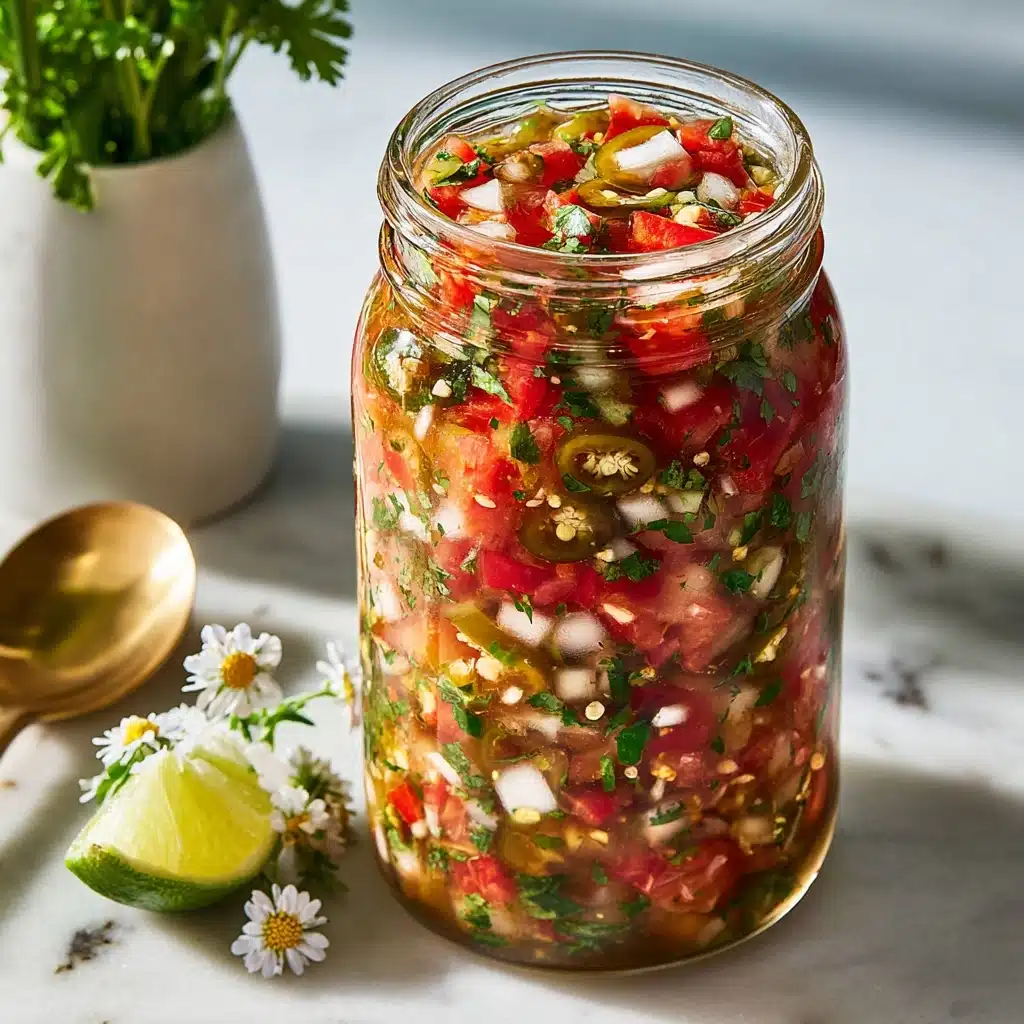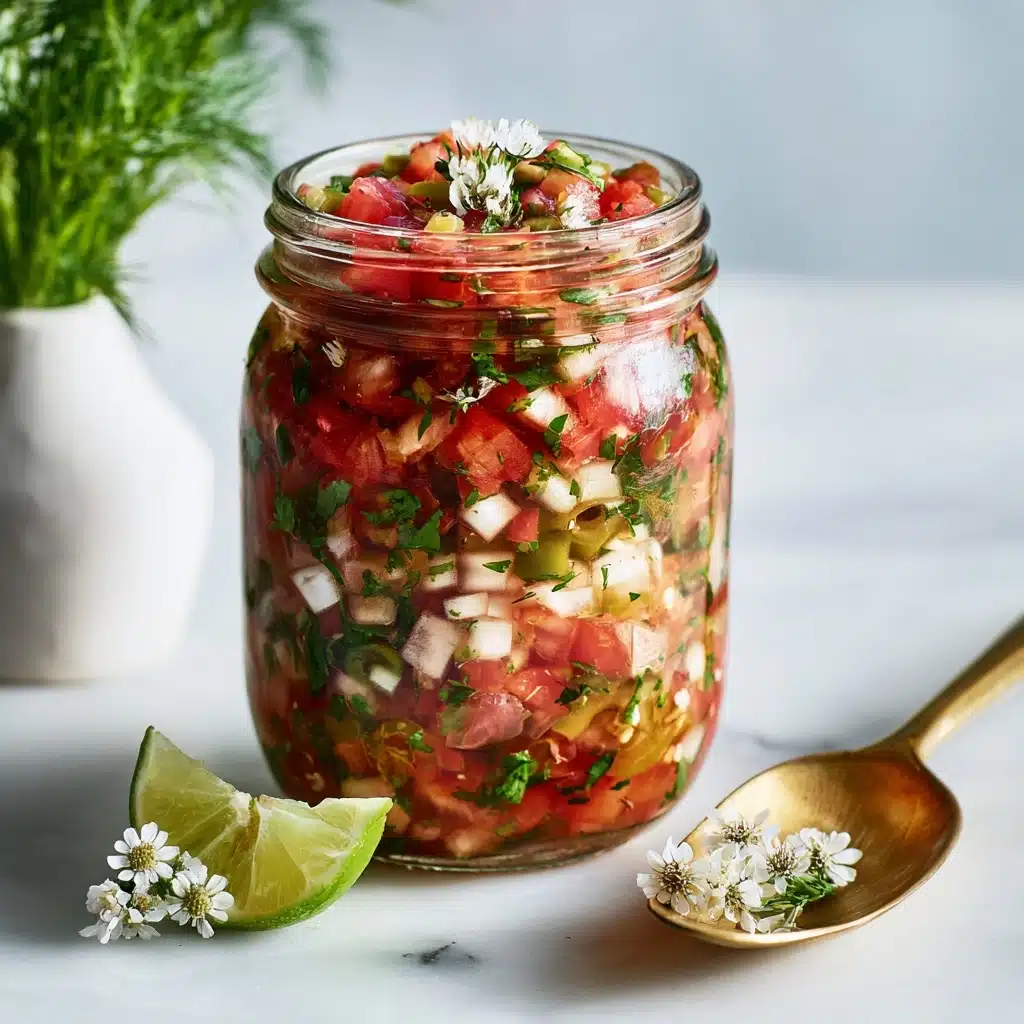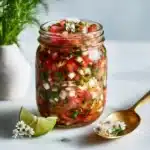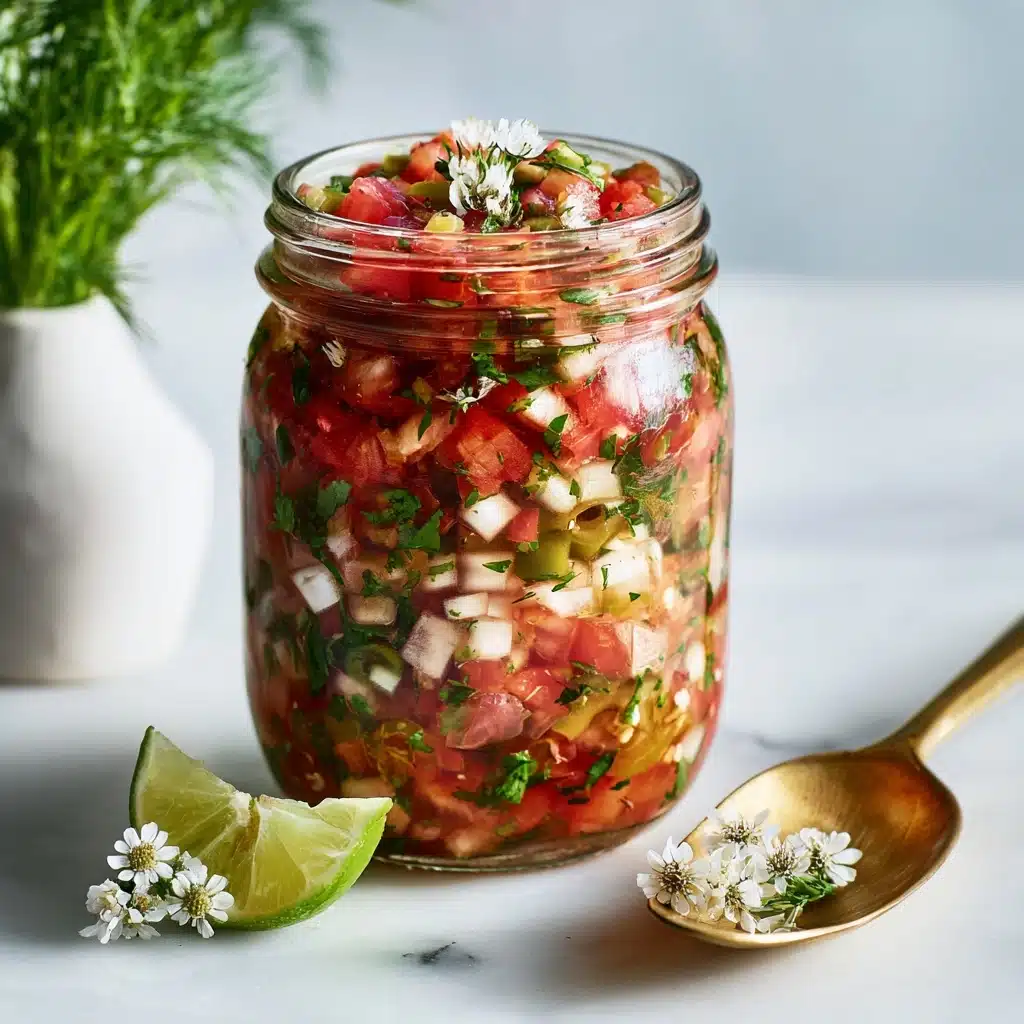If you’re looking to bring a tangy, probiotic kick to your favorite snacks and meals, let me introduce you to Fermented Salsa. This lively condiment isn’t just a vibrant, flavor-packed dip; it’s a totally different salsa experience, brimming with healthy bacteria and bright, garden-fresh ingredients. Imagine all the best parts of classic salsa—zesty tomatoes, spicy jalapeño, aromatic cilantro—but with a quirky, irresistible twist that comes from natural fermentation. Every spoonful is a burst of color, crunch, and complex, living flavor. If you’re ready to wow your taste buds and add something truly special to your table, this Fermented Salsa recipe has your name on it!

Ingredients You’ll Need
The beauty of fermented salsa is in its short, straightforward ingredient list. Each component brings its own magic—vivid color from tomatoes, fiery excitement from jalapeños, and that essential freshness from cilantro. Use the best you can get your hands on, because in a simple recipe like this, every flavor counts.
- 4 large ripe tomatoes, chopped: Go for the juiciest, ripest tomatoes you can find—they’re the heart and soul of this salsa and will ensure maximum flavor and a satisfying texture.
- 1 small onion, finely chopped: Onion adds sharpness and a delightful crunch, cutting through the acidity and heat for perfect balance.
- 2 cloves garlic, minced: Fresh garlic provides a subtle heat and a pungent depth that melds beautifully with the other ingredients as it ferments.
- 1 jalapeño pepper, seeded and chopped: This pepper brings just the right amount of kick—remove most seeds if you want a milder salsa, or leave a few in if you love some extra heat.
- 1/4 cup fresh cilantro, chopped: Cilantro adds a burst of freshness and a pop of vibrant green; adjust the amount to suit your taste for this polarizing herb.
- 1 tablespoon sea salt: Salt is not just for flavor—it jump-starts the fermentation process by keeping unwanted bugs at bay while letting beneficial bacteria flourish.
- 1 tablespoon lime juice: Add this at the end to ramp up the brightness and preserve that classic salsa zing.
How to Make Fermented Salsa
Step 1: Chop, Prep, and Combine the Good Stuff
This step is all about layering flavor and creating that signature chunky salsa texture. Start by finely chopping the ripe tomatoes, onion, jalapeño, garlic, and cilantro. Toss them into a large mixing bowl, sprinkle over the sea salt, and stir. You’ll notice the salt starts to draw out the juices—this is exactly what you want, as the salty liquid will help create the brine needed for fermentation.
Step 2: Pack and Submerge
Transfer your salsa mixture into a squeaky-clean glass jar, making sure to press it down firmly with a spoon. The goal is to keep all those gorgeous veggies submerged beneath their own juices—this helps them ferment safely and evenly. Leave a little space (about 1 inch) at the top of the jar to give the salsa room to bubble and breathe.
Step 3: Cover and Ferment
Cover the jar with a breathable cloth secured with a rubber band, or use a fermentation lid if you have one. This allows gases to escape while blocking out any unwanted particles. Set the jar aside at room temperature, away from direct sunlight. Peek every day—watch for bubbles, and give it a taste after three days. When the flavor is a little tangy and totally irresistible, you’re ready to move on.
Step 4: Finish and Chill
Once your Fermented Salsa has reached your favorite sourness (usually 3 to 5 days), stir in the lime juice for that signature brightness. Transfer your jar to the refrigerator to slow down fermentation and preserve the flavors. The salsa will keep developing subtle complexity, so get ready for it to keep surprising you!
How to Serve Fermented Salsa

Garnishes
For that restaurant-worthy look, top your bowl of fermented salsa with extra chopped cilantro, a drizzle of olive oil, or even a few thin slices of fresh jalapeño. Adding colorful garnishes not only makes your salsa pop but also adds texture and flavor right at the finish.
Side Dishes
This salsa is wildly versatile. It shines alongside crispy tortilla chips, but is equally at home dolloped onto tacos, mixed into burrito bowls, or spooned over grilled veggies. The lively tang makes it a natural sidekick for anything rich or savory—think black beans, grilled tofu, or even roasted potatoes.
Creative Ways to Present
If you want to wow friends with your fermented salsa, serve it in small mason jars with big tortilla wedges for dipping, or pile generous spoonfuls onto mini tostada shells for a vibrant appetizer. It’s also fantastic as a topping for scrambled eggs or as a mix-in for guacamole. Don’t be shy—let your imagination run wild!
Make Ahead and Storage
Storing Leftovers
Fermented Salsa stores beautifully in the fridge, lasting up to 2–3 weeks if kept tightly sealed. The flavors keep developing, so you might even find it tastes more complex after a few days. Always use a clean spoon to avoid introducing unwanted bacteria.
Freezing
While you technically can freeze fermented salsa, the texture of the vegetables may soften after thawing. If you do go this route, freeze in airtight containers and thaw in the refrigerator—just be prepared for a softer, still-tasty salsa. For the best flavor and probiotic benefits, fresh is ideal!
Reheating
Fermented Salsa is meant to be enjoyed cold or at room temperature, so there’s really no need to reheat it. Warming it could diminish both the flavor and those wonderful live probiotics. Just give it a good stir and serve it straight from the fridge.
FAQs
Can I use different peppers in fermented salsa?
Absolutely! Feel free to swap in serrano, poblano, or even sweet peppers for a different twist. Just be aware that the heat level will change depending on the type Condiment.
How do I know if my salsa is safely fermented?
Trust your senses—well-fermented salsa should smell pleasantly sour and a little yeasty, never rotten or off. As long as the veggies stay submerged and there’s no slime or fuzzy mold, you’re in the clear. Some bubbling and cloudiness are actually signs that fermentation is happening as it should!
Can I omit the cilantro?
Yes! If cilantro isn’t your thing (or for those with the cilantro-tastes-like-soap gene), simply leave it out or replace it with fresh parsley. Your fermented salsa will still be bursting with flavor.
What if my kitchen is very warm or cold?
Fermentation time will speed up in a warm kitchen and slow down in a colder one. Taste daily—a warm room might make your salsa tangy in just two days, while a chillier spot could take 5 or more. Adapt times to match your own environment and preferred zinginess.
Can I make a bigger batch?
Of course! Just double or triple the recipe, using the same ratios, and ferment in a larger jar or crock. Make sure to keep everything submerged in brine—it’s the secret to happy, safe fermentation.
Final Thoughts
If you’ve never tried making Fermented Salsa before, this is your sign to go for it! You’re just a handful of fresh ingredients and a few days away from a punchy, probiotic snack that’s as fun to make as it is to eat. Trust me: once you taste the sparkle and depth homemade fermentation brings, your chips (and tacos, and burrito bowls) will never be the same again. Enjoy every tangy bite!
Print
Fermented Salsa Recipe
- Total Time: 3 to 5 days
- Yield: About 3 cups 1x
- Diet: Vegan, Gluten-Free
Description
Learn how to make your own tangy and probiotic fermented salsa at home with this simple recipe. This fermented salsa is packed with fresh ingredients and is perfect as a condiment or dip.
Ingredients
Tomato Mixture:
- 4 large ripe tomatoes, chopped
- 1 small onion, finely chopped
- 2 cloves garlic, minced
- 1 jalapeño pepper, seeded and chopped
- 1/4 cup fresh cilantro, chopped
- 1 tablespoon sea salt
Addition:
- 1 tablespoon lime juice
Instructions
- Combine Ingredients: In a large mixing bowl, combine the chopped tomatoes, onion, garlic, jalapeño, cilantro, and salt. Stir thoroughly to mix and release juices.
- Transfer: Transfer the mixture into a clean glass jar, pressing down firmly to remove air pockets and submerge the ingredients in their juices.
- Ferment: Leave about 1 inch of headspace, cover with a cloth or fermentation lid, and ferment at room temperature away from direct sunlight for 3 to 5 days, tasting daily.
- Finish: Once desired tanginess is reached, stir in lime juice and refrigerate to slow fermentation. Serve chilled as a condiment or dip.
Notes
- Use fresh, ripe tomatoes for best results.
- Keep ingredients submerged to prevent mold.
- Adjust fermentation time based on taste and room temperature.
- Prep Time: 15 minutes
- Cook Time: 3 to 5 days (fermentation time)
- Category: Condiment
- Method: Fermentation
- Cuisine: Mexican
Nutrition
- Serving Size: 2 tablespoons
- Calories: 10
- Sugar: 2g
- Sodium: 200mg
- Fat: 0g
- Saturated Fat: 0g
- Unsaturated Fat: 0g
- Trans Fat: 0g
- Carbohydrates: 2g
- Fiber: 1g
- Protein: 0g
- Cholesterol: 0mg







